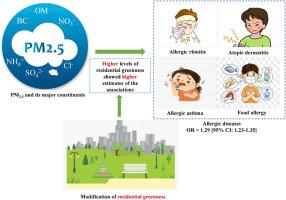住宅绿化改变了长期暴露于PM2.5成分与学童过敏性疾病之间的关系:中国南方的一项大规模研究
IF 7.3
2区 环境科学与生态学
Q1 ENVIRONMENTAL SCIENCES
引用次数: 0
摘要
关于学童长期暴露于细颗粒物(PM2.5)成分和过敏性疾病[变应性鼻炎(AR)、过敏性哮喘、特应性皮炎和食物过敏]以及住宅绿化的调节作用的证据仍然有限。我们对中国四个城市的69,341名学童进行了横断面研究和问卷调查,以收集有关过敏性疾病的信息。PM2.5和六种组分[硝酸盐(NO3-)、硫酸盐(SO42-)、有机物(OM)、氯化物(Cl-)、黑碳(BC)和铵(NH4+)]的高分辨率(1 km × 1 km)浓度来源于中国大气污染物数据集。利用卫星反演的归一化植被指数(NDVI)对住宅绿化度进行评价。采用广义线性混合模型和加权分位数和(WQS)回归分别评价PM2.5成分对变应性疾病的个体效应和混合效应。PM2.5平均浓度为28.48 μg/m3。PM2.5暴露与AR风险增加相关(调整优势比(or) = 1.04 /四分位数范围(IQR)增加;95% ci: 1.00, 1.08)。SO42-和NH4+与变应性疾病呈正相关。WQS分析显示,六种成分的联合暴露显著增加了过敏性疾病的风险(OR = 1.29, 95% CI: 1.23, 1.35),其中SO42-和NH4+的混合物毒性占主导地位。较高的绿化程度加重了PM2.5及其组分对变应性疾病和AR的不良影响。综上所述,水溶性离子(SO42-和NH4+)主要驱动小学生PM2.5相关变应性疾病的风险,绿化程度可能强化PM2.5组分对变应性疾病的不良影响。本文章由计算机程序翻译,如有差异,请以英文原文为准。

Residential greenness modifies the association between long-term exposure to PM2.5 components and allergic diseases in schoolchildren: A large-scale study in Southern China
Evidence remains limited regarding long-term exposure to fine particulate matter (PM2.5) components and allergic diseases [allergic rhinitis (AR), allergic asthma, atopic dermatitis, and food allergy] in schoolchildren, and the modifying role of residential greenness. We conducted a cross-sectional study and administered a questionnaire survey to 69,341 schoolchildren across four cities in China to gather information on allergic diseases. High-resolution (1 km × 1 km) concentrations of PM2.5 and six components [nitrate (NO3-), sulfate (SO42-), organic matter (OM), chloride (Cl-), black carbon (BC), and ammonium (NH4+)] were derived from the ChinaHighAirPollutants dataset. Residential greenness was assessed using satellite-derived Normalized Difference Vegetation Index (NDVI). Generalized linear mixed models and weighted quantile sum (WQS) regression were used to evaluate the individual and mixture effects of PM2.5 components on allergic diseases, respectively. The average concentration of PM2.5 was 28.48 μg/m3. PM2.5 exposure was associated with an increased risk of AR (adjusted odds ratios (ORs) = 1.04 per interquartile range (IQR) increase; 95% CI: 1.00, 1.08). SO42- and NH4+ were positively associated with allergic disease. WQS analysis revealed joint exposure to the six constituents significantly increased risks for allergic disease (OR = 1.29, 95% CI: 1.23, 1.35), with SO42- and NH4+ dominating the mixture toxicity. Higher greenness exacerbated the adverse effects of PM2.5 and its components on allergic diseases and AR. In conclusion, water-soluble ions (SO42- and NH4+) primarily drive PM2.5-associated allergic disease risks in schoolchildren, and greenness may strengthen the adverse effects of PM2.5 components on allergic diseases.
求助全文
通过发布文献求助,成功后即可免费获取论文全文。
去求助
来源期刊

Environmental Pollution
环境科学-环境科学
CiteScore
16.00
自引率
6.70%
发文量
2082
审稿时长
2.9 months
期刊介绍:
Environmental Pollution is an international peer-reviewed journal that publishes high-quality research papers and review articles covering all aspects of environmental pollution and its impacts on ecosystems and human health.
Subject areas include, but are not limited to:
• Sources and occurrences of pollutants that are clearly defined and measured in environmental compartments, food and food-related items, and human bodies;
• Interlinks between contaminant exposure and biological, ecological, and human health effects, including those of climate change;
• Contaminants of emerging concerns (including but not limited to antibiotic resistant microorganisms or genes, microplastics/nanoplastics, electronic wastes, light, and noise) and/or their biological, ecological, or human health effects;
• Laboratory and field studies on the remediation/mitigation of environmental pollution via new techniques and with clear links to biological, ecological, or human health effects;
• Modeling of pollution processes, patterns, or trends that is of clear environmental and/or human health interest;
• New techniques that measure and examine environmental occurrences, transport, behavior, and effects of pollutants within the environment or the laboratory, provided that they can be clearly used to address problems within regional or global environmental compartments.
 求助内容:
求助内容: 应助结果提醒方式:
应助结果提醒方式:


